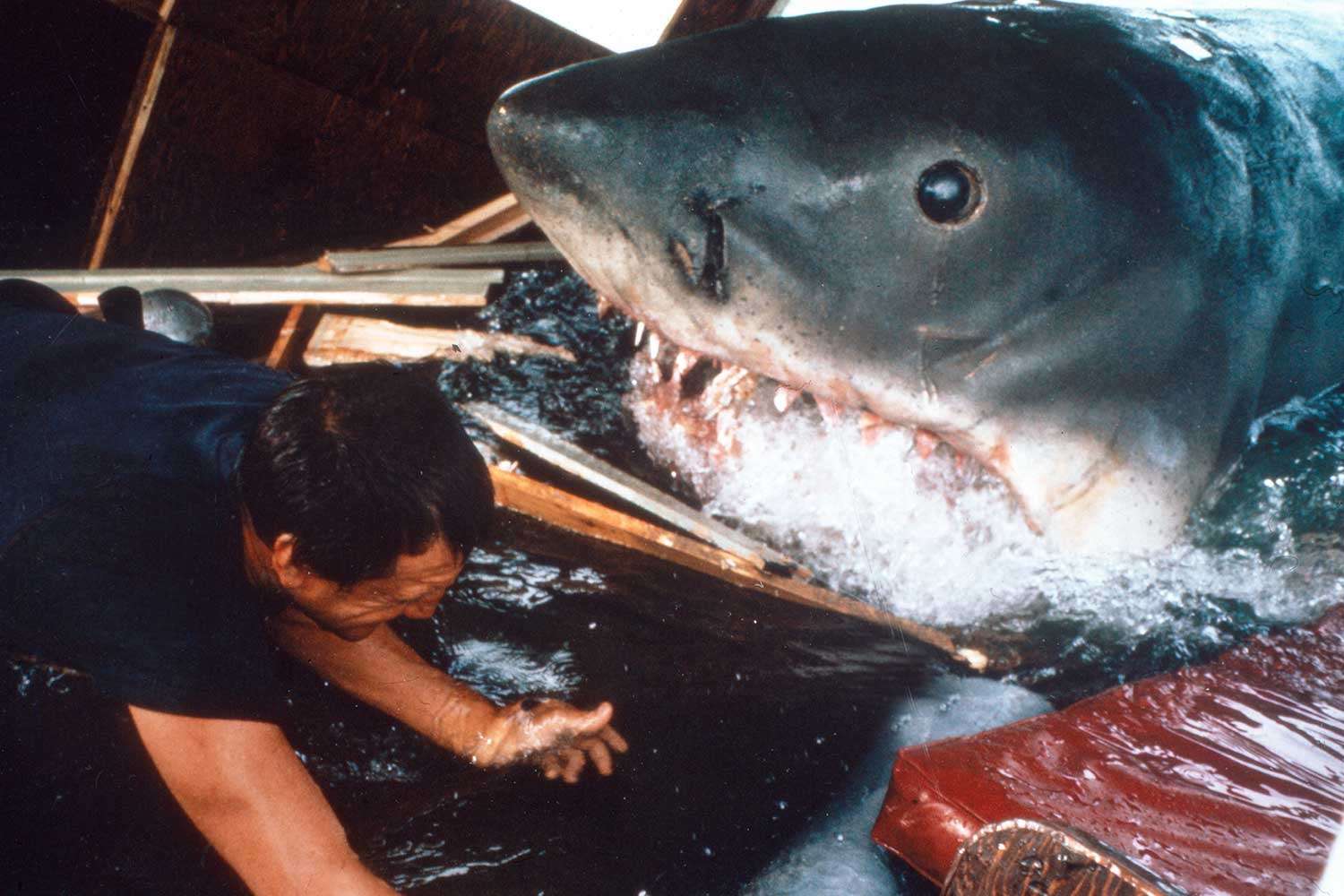:max_bytes(150000):strip_icc():format(jpeg)/jaws-bts-shark-1975-061325-54273ad3144c41d4bd7bbd496294c555.jpg)
NEED TO KNOW
- The production designer of Jaws says the studio initially balked at the film — until a young Steven Spielberg convinced them it would be “big”
- Joe Alves, the film’s production designer, tells PEOPLE how difficult it was to create the animatronic sharks for the film
- “While we made the film, we were treated like it wasn’t very special,” he says. “It was just a dumb shark movie … until it came out”
It’s been 50 years, but Joe Alves vividly remembers the day he was contacted with an unusual request: “Can you build a shark?”
Alves, now 89, had already been working as an art director for more than a decade when he was sent galley sheets of a book that was to be published in 1974. The novel, written by Peter Benchley, revolved around a small resort town terrorized by a Great White shark and the efforts of three men to kill it.
Studio executives wanted to turn the book into a movie — so they called Alves to help.
“They first asked if I could illustrate the shark in order to sell the book to the studio,” he recounts in a recent interview with PEOPLE.
Chris Polk/FilmMagic for Universal Studio Home Video
As the film wasn’t yet in production, they initially couldn’t even pay Alves, who got to work on his drawings, which he based on countless videos of Great White sharks swimming in the ocean.
“I took the drawings to the studio head, and that’s when they brought Spielberg in [as the film’s director],” he says. “I went in through my whole dissertation, and that’s when the studio asked the effects company: ‘Can you build the shark?’ ”
As Alves remembers, the effects company initially balked at the idea of building a large animatronic shark for a film based on a book that hadn’t even been published yet.
“They said no. They said, ‘We have a bigger movie — The Hindenburg,’ ” he says, talking about the 1975 film based on the 1937 Hindenburg disaster. “But Spielberg said, ‘This will be bigger than the Hindenburg.’ ”
Indeed, Jaws was a far more culturally resonant film than The Hindenburg, and also wound up far surpassing box office estimates (Jaws grossed $273.6 million domestically and $210.7 million internationally, while The Hindenburg only brought in around $27 million domestically).
Initially, recounts Alves, it was just a “little shark movie” — albeit one he and Spielberg were convinced had big potential.
After Spielberg made the remark about The Hindenburg, “everyone laughed,” Alves said, and he gathered his drawings to leave the room. Having heard from a special effects team that a lifelike animatronic shark just couldn’t be made, one studio exec had a question: “They wanted to know if I could get the shark made, and I said yes.”
“So my next situation was: I had to do some research,” he adds.
Alves connected with a marine biologist, who said that “the perfect shark” would be 12 feet long. So he decided he needed to make one twice that size.
“We decided, okay, if we’re going to do this, let’s make a 25-foot shark and shoot it in the real ocean. That had really never been done. I spoke to a lot of effects people who said it would take about a year or a year-and-a-half of testing to figure out how to make it work,” he recounts.
Time wasn’t on his side, but Alves got to work crafting clay-modeled versions of the shark.
“I worked with the marine biologists to get the shark to look exactly like a Great White — but bigger,” he says.
FilmPublicityArchive/United Archives via Getty
Eventually, Alves was introduced to Bob Mattey, a mechanical effects expert credited with bringing the giant squid to life in Disney’s 1954 film, 20,000 Leagues Under the Sea.
“I needed three sharks: one that went right to left, one that went left to right and another on a crane that could be tilted,” Alves says, adding that the film crew eventually gave the shark a name: Bruce.
Then, he had to scout locations, eventually settling on Martha’s Vineyard because it had water in which the crew could film. But then came the issue of getting the sharks there.
“The sharks were built in LA, in the lot at a huge warehouse,” Alves says, explaining that studio executives gave him just months to build them. “We built as much as we could in the time we had.”
Then, the animatronics were loaded onto a truck to be transported cross-country — and their weight broke the supports on the vehicle.
By the time the sharks arrived and filming began, it was spring in Martha’s Vineyard, with cold temperatures leading to harsh conditions for many of the young actors tasked with shooting in the water.
“Salt water doesn’t like electricity, so any time [water] got in the sharks, they would stop moving,” he explains. “It was also really cold, and we had kids on the beach. So I would say to Steven, ‘If the shark works, shoot it.’ ”
Sunset Boulevard/Corbis via Getty
When the shark stopped working, the team would quickly work to fix it.
“At one point while we were shooting, the whole top of the teeth started coming out of the shark,” Alves says. “So I ran in and shoved the teeth back. We didn’t even stop filming.”
But after months spent with “Bruce,” filming wrapped — at least, temporarily.
“We finish, they did a screening in Texas, Steven turned to me and said, ‘I want a shot of the shark breaking a hull,’ ” Alves recounts, adding the director also had an unusual request: that they get a shot of a fisherman’s head post shark attack.
Alves built two hulls in his own backyard and “stole” a head from the film’s makeup department. The resulting scene is a jump-scare and an iconic moment in movie history — one that Alves says was shot partially in his driveway, with a hose.
“Steven pieced that together, cut it in the film, and we had a screening with the head,” he says. “It became a shock movie.”
The shock value was a surprise for those involved in the making of the film, with Alves noting that the sharks made “funny sounds” due to their mechanics. Alves and the production team worried that people watching the film in theaters might find it funny — “but they didn’t laugh,” he adds.
Universal/Kobal/Shutterstock
In fact, the studio initially planned a limited release of the film, he says, until an executive went to a screening and heard the screams from the audience.
“Just based on the reaction of the audience, he immediately demanded they do a much wider release,” says Alves.
Never miss a story — sign up for PEOPLE’s free daily newsletter to stay up-to-date on the best of what PEOPLE has to offer, from celebrity news to compelling human interest stories.
That the film would go on to become a box office juggernaut and propel Spielberg to household name status was a surprise to many involved — even Alves.
“While we made the film, we were treated like it wasn’t very special,” he says. “It was just a dumb shark movie … until it came out.”
The sole surviving full-scale model of Bruce is now on display at the Academy Museum of Motion Pictures in Los Angeles.

